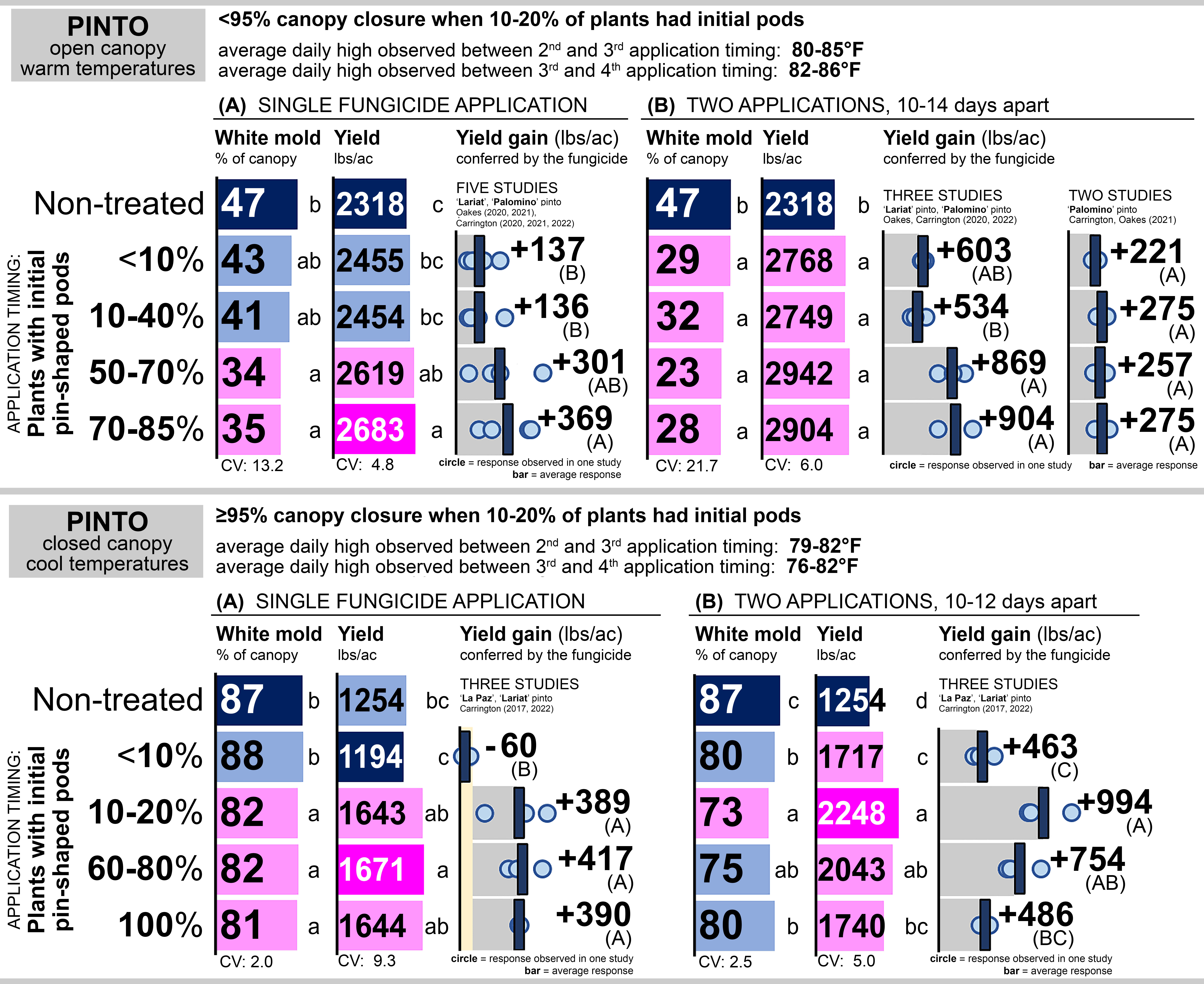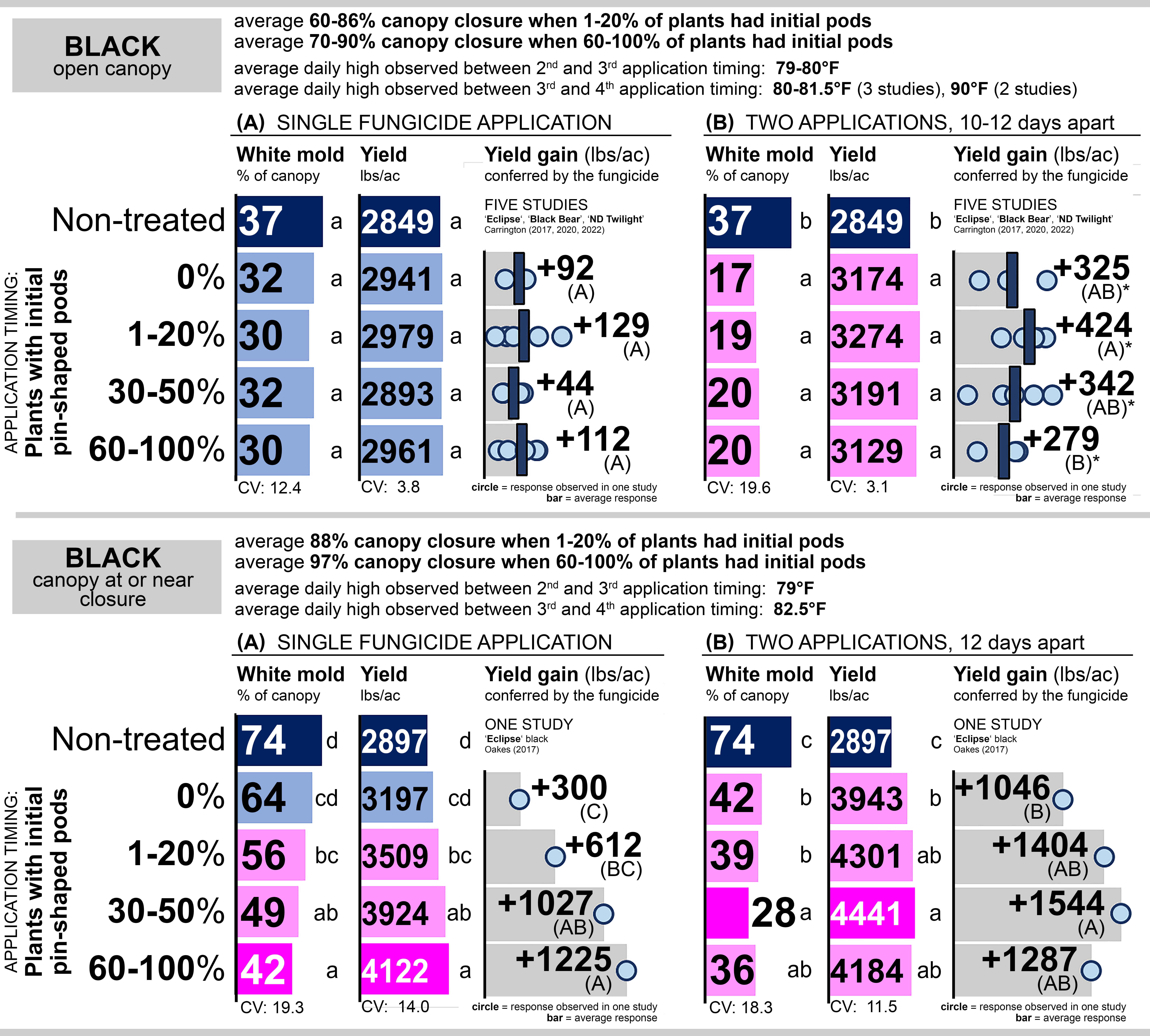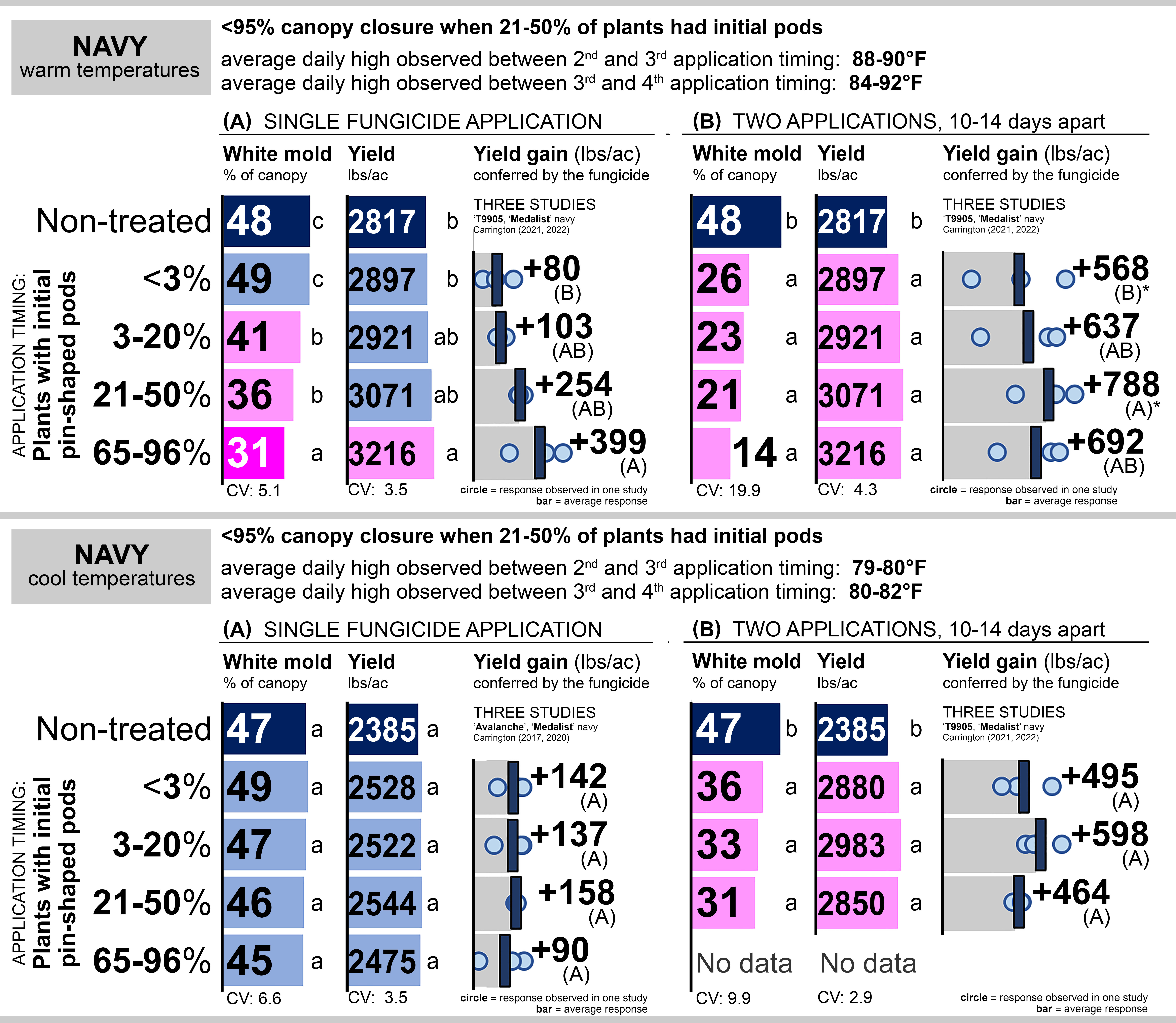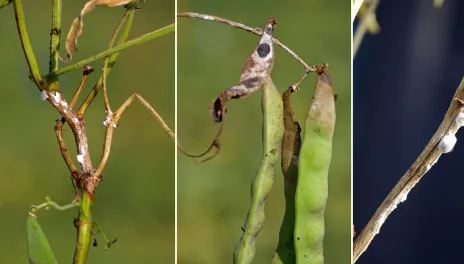Optimizing fungicide application timing for improved management of white mold in pinto, navy, and black beans
Fungicide application timing research conducted in Carrington and Oakes from 2017-2022 on pinto, black, and navy beans indicates that when conditions favor white mold as dry beans enter bloom, fungicide applications should be calibrated relative to the percent of plants with initial pin-shaped pods and daytime high temperatures.
When making two sequential fungicide applications, the first application should be made at initial appearance of pin-shaped pods if daytime high temperatures are in the upper 70°F to low 80°F range at that growth stage and conditions favor white mold. For white mold to develop, soil moisture in the top inch of the soil must be sufficient for the mushroom-like spore-producing apothecia to develop on the soil surface below the dry bean canopy, and there must be sufficient canopy wetness to facilitate pathogen infection (rainfall, irrigation, or nighttime dew). In irrigated field trials conducted when temperatures were within this range during initial pod development, fungicide timing was optimized when 10-20% of plants had initial pods (pinto beans), 3-20% of plants had initial pods (navy beans), or 1-20% or 30-50% of plants had initial pods (black beans).
When daytime high temperatures are in the mid-80°F to low 90°F range at initial pod development but conditions otherwise favor white mold, applications should be delayed by 2 to 4 days until there are more dead blossoms in the dry bean canopy and susceptibility to white mold is higher. In field trials where high temperatures averaged in the mid-80°F to low 90°F range at initial pod, fungicide timing was optimized when the first application (in a two-application sequence) was made when 50-85% of plants with had initial pin-shaped pods (pinto beans) or 21-50% of plants with initial pin-shaped pods (navy beans). No testing was conducted in black beans at these temperatures.
When a single fungicide application is made targeting white mold, results from the field trials suggest that the application should be delayed by 2 to 3 days (versus the timing that would be used for the first application in a two-application sequence). A single fungicide application does not confer sufficient residual to protect dry beans for the entire bloom period. When a single fungicide application is made, it is best to delay the application slightly in order to extend protection through more of the critical full bloom period when dry beans are at their height of susceptibility to white mold.
In the studies conducted on pinto beans, differences in canopy closure may have also contributed to the observed differences in optimal application timing. In the studies in which cool weather was observed at initial pod development, the pinto bean canopy was at or near closure at this growth stage. In the studies in which warm weather was observed at initial pod development, the pinto bean canopy was open (< 95% canopy closure) at this growth stage.
One of the major lessons from this research is that there is a sharp yield penalty associated with applying fungicides targeting white mold either too early or too late. Achieving satisfactory management of white mold with fungicides requires careful attention to crop growth stage and disease risk. Fungicides do not translocate into new growth; they only protect the tissues to which they are applied. When fungicides are applied before there are sufficient dead blossoms to facilitate significant white mold infection, there is a significant yield penalty due to the unprotected new growth. However, there is also a significant yield penalty to applying too late. Fungicides must be applied preventatively before pathogen infection (or, in the case of the best curative products, within 24 hours of pathogen infection, typically 1-2 weeks before disease symptoms appear). Applications made after pathogen infection are completely ineffective.
Major findings – pinto beans (Carrington and Oakes; 2017, 2020-2022). Topsin (30 or 40 fl oz/ac) was applied once or as the first application prior to Endura (8 oz/ac) 10-14 days later.
- When the canopy was open and temperatures were in the mid- to upper 80°F range, fungicide performance was maximized by delaying applications until 50-85% of plants had pin-pods (for the first application of a two-application sequence) or until 70-85% of plants had pin-pods (single application).
- When the canopy was at or near closure and daytime highs were predominantly in the mid-70 to low 80°F range, fungicide performance was maximized with applications made when 10-20% of plants had pin-pods (two sequential applications) or 60-80% of plants had pin-pods (single application).

Within-column means followed by different letters are significantly different (P < 0.05).
Major findings – black beans (Carrington and Oakes; 2017, 2020, 2022). Topsin (30 or 40 fl oz/ac) was made as a single application or as the first application prior to Endura (8 oz/ac) 10-14 days later.
- Across all six studies conducted on black beans from 2017 to 2022, the canopy was open (< 95% closure) and temperatures were cool (mid 70 to low 80°F range) when black beans were at initial pod (< 50% of plants with initial pin-shaped pods).
- A single fungicide application was often insufficient, and satisfactory white mold management was consistently achieved only with two sequential applications.
- When making the first application of a two-application sequence, yields were optimized when applications were made at 1-20% or 30-50% of plants with initial pods.

Within-column means followed by different letters are significantly different (P < 0.05) or (P < 0.10) if followed by an asterisk.
Major findings – navy beans. (Carrington; 2017, 2020-2022). Topsin (30 or 40 fl oz/ac) was made as a single application or as the first application prior to Endura (8 oz/ac) 10-12 days later.
- When daytime high temperatures were predominantly in the mid- 80 to low 90°F range, fungicide performance was maximized when the first application of a two-application sequence was made when 21-50% of plants had initial pin-pods. When a single application was made, fungicide performance was optimized when 65-96% of plants had pin-pods.
- When daytime high temperatures were predominantly in the mid- 70 to low 80°F range, fungicide performance was maximized when the first application of a two-application sequence was made when 3-20% of plants had initial pin-pods. When a single application was made in cool weather, white mold overwhelmed the fungicide, and no difference was observed across application timings.

Within-column means followed by different letters are significantly different (P < 0.05) or (P < 0.10) if followed by an asterisk.
Methods:
To rigorously evaluate the growth stage at which fungicides should be applied to dry beans when weather conditions favor white mold, field studies were conducted under overhead irrigation in Carrington and Oakes, ND in 2017, 2020, 2021, and 2022. The Carrington location has loam soils, and the Oakes location is irrigated sand. Testing was conducted on dry beans seeded at 90,000 viable seeds/ac (pinto, kidney beans) or 100,000 viable seeds/ac (navy, black beans). Row spacing was 14 inches in Oakes in 2017 and both study locations in 2020, 2021, and 2022. In Carrington in 2017, parallel studies were conducted with narrow (14-inch) and wide (28-inch) row spacing. Fungicides were applied in 15 gal/ac with a hand-held boom equipped with TeeJet XR, DG, or AIXR flat-fan nozzles. In 2017, all applications were made with fine droplets (Oakes) or medium droplets (Carrington). In 2020 to 2022, fungicide droplet size was calibrated relative to canopy closure, with fine or medium droplets utilized when canopy closure was < 90%, medium-coarse or coarse droplets utilized when canopy closure was 90-95%, and coarse droplets utilized when canopy closure was >95%.
The percent of plants with initial pin-shaped pods was utilized to characterize fungicide application timing. Dry beans produce small pin-shaped pods as soon as blossoms senesce, and dead blossoms are shed as the pin-shaped pods are produced. Nearly all white mold infections are initiated on dead blossoms, and the percent of plants with dead blossoms is a better predictor of susceptibility to white mold than the percent of plants with open blossoms.
Four application timings were evaluated. The first application was made at early bloom when fewer than 10% of plants had initial pin-shaped pods, and subsequent timings were spaced 2 or 4 days apart. Because the initial pin-shaped pods are produced as a blossom senesces, the percent of plants with initial pods is equivalent to the percent of plants with dead blossoms. Testing was conducted with a single fungicide application of Topsin (30 or 40 fl oz/ac) or with sequential applications of Topsin followed by Endura (8 oz/ac) 10-14 days apart.
Irrigation was managed to create conditions favorable for white mold. To facilitate apothecia production as dry beans entered bloom, irrigation was applied as needed to maintain the top inch of the soil moist from late vegetative growth through the end of bloom. In Carrington, overhead irrigation was delivered with low-output micro-sprinklers, with a minimum 0.5 inches applied over a 12-hour period between each application.
Research conducted by Michael Wunsch, Thomas Miorini, Jesse Hafner, Suanne Kallis, and Aaron Fauss; NDSU Carrington Research Extension Center. Kelly Cooper, Heidi Eslinger, Leonard Besemann, Spencer Eslinger; NDSU Robert Titus Irrigation Research Site, Oakes.
Michael Wunsch, Ph. D.
Michael.Wunsch@ndsu.edu
Plant Pathologist
